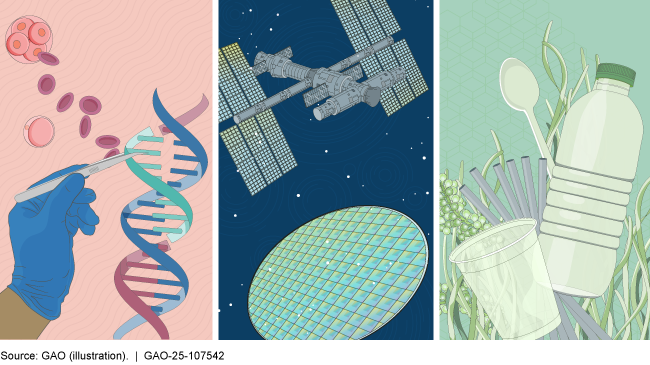On the Horizon: Three Science and Technology Trends that Could Affect Society
Fast Facts
In our first periodic report on science and technology trends, we looked at 3 emerging technologies.
Gene editing could improve disease treatment and prevention, and have benefits like increasing lifespans
Manufacturing in space could allow more efficient production of higher-quality semiconductor materials, which could help meet demand for technologies such as AI
Biodegradable bioplastics—plastics made from biological materials—break down more quickly than traditional plastics and may help reduce pollution
Our report looks at the status of these technologies, their potential implications, and considerations for policymakers and others.

Highlights
What GAO Found
GAO identified three technologies in science, technology, and engineering that are trending toward maturity. These technologies are:
- Gene editing to treat or prevent disease, which may advance treatments for diseases such as cystic fibrosis. The development of gene editing may be limited by ethical concerns, particularly when factors such as whether the results of such editing can be inherited by children are included. Implications of such technologies include the high costs—currently over $2 million per patient—and whether federal funds may be used for certain types of gene editing. A potential consideration for policymakers, such as legislative bodies, government agencies, and other groups, is how the current federal funding restrictions may affect future gene editing research.
- Space-based manufacturing of semiconductor crystals, which may enable the production of high-quality semiconductors. The unique conditions of space—such as microgravity, a natural vacuum, and reduced contamination—could enable the production of semiconductor crystals with fewer defects and greater purity than those manufactured on Earth. These semiconductors could lead to more powerful computers, faster communication systems, and improved consumer electronics. The implications of such technologies include the dependency on foreign supply chains for raw materials, and safeguarding the spacecraft needed for enabling such manufacturing. A potential consideration for policymakers is whether a comprehensive licensing framework for investment, development, and intellectual property protection would benefit the development of these technologies.
- Biodegradable bioplastics, which may help reduce microplastic pollution through recent innovations, including algae-based or self-biodegradable bioplastics. The implications of such technologies include carbon dioxide emissions from biodegradation as well as increased complexity for consumers to make eco-friendly choices. Potential considerations for policymakers are increased clarity for labeling of such technologies, such as explicit notation of the conditions needed for biodegradation, and increased consumer education to help align the expectations of the technologies’ end of life procedures with consumer behavior.

Why GAO Did This Study
Science and technology are constantly evolving, and there is a need for analysis of emerging trends of the future to help prepare for disruptions that may have major impacts in the lives of Americans. To address this need, GAO developed this report focused on technologies approximately 10 years on the horizon. The goal is to provide foresight into developing technologies that could have significant impacts on Americans.
GAO described developments in these technologies and how they may be affected by various elements which may be useful for policymakers, such as legislative bodies, government agencies, or other groups, to consider. These elements include the five domains in the STEER framework: social impacts, technology drivers, environmental impacts, economic drivers, and the regulatory landscape.
To conduct this work, GAO relied on a review of scientific literature from academic journals and position papers and held semi-structured interviews with five experts across the three technologies. GAO relied on the judgment of its engineers and scientists and consideration of the collected information to describe key aspects of the technological trends, including identifying technological developments, market conditions, or economies of scale that could further accelerate the maturity of these new technologies, and considerations for policymakers.;
For more information, contact Sterling Thomas, PhD, at (202) 512-6888 or ThomasS2@gao.gov or Stephen Sanford, at (202) 512-4707 or sanfords@gao.gov.
